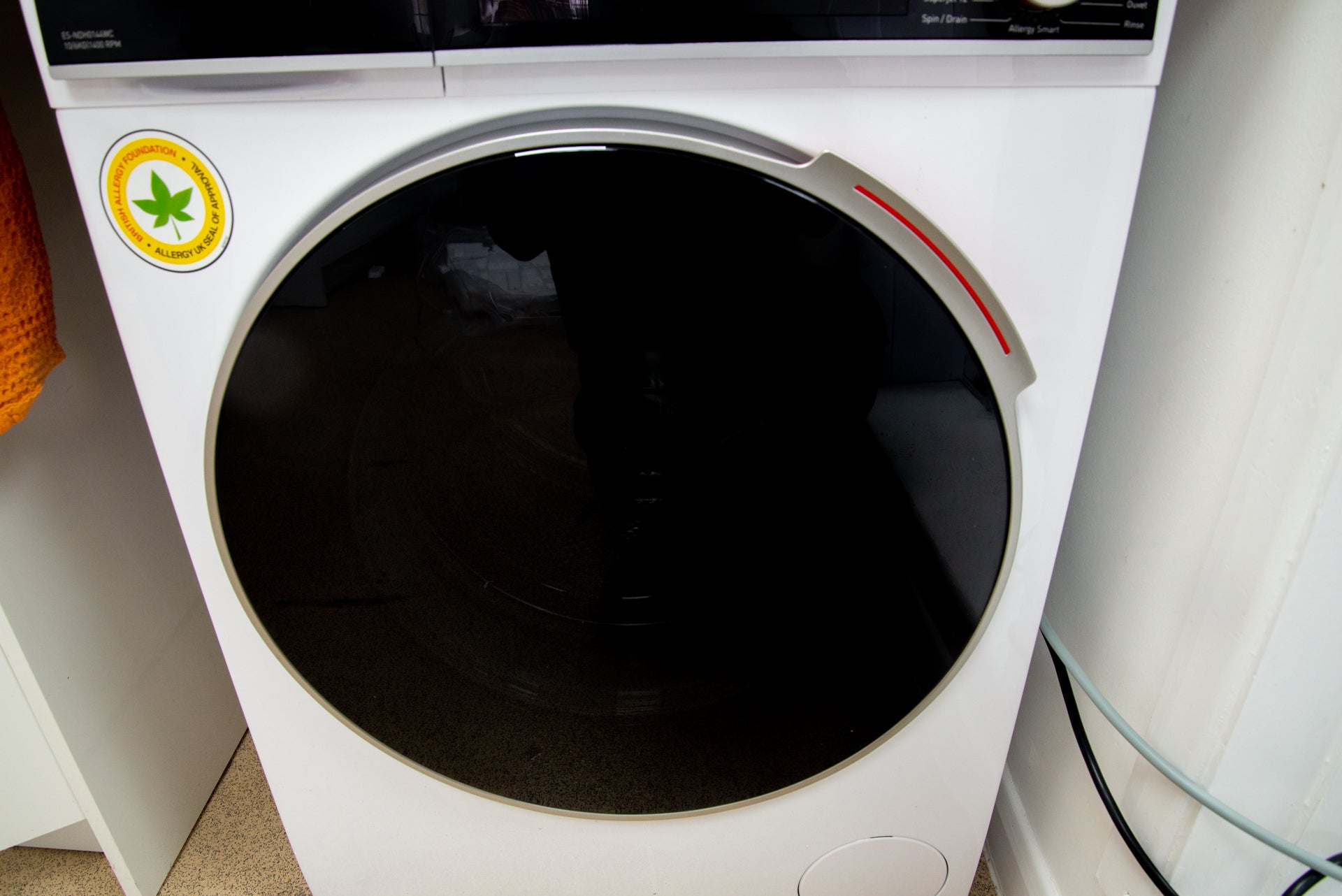Thanks to its large 10kg drum, the Sharp ES-NDH0144WC-EN washer-dryer can handle both big loads and larger items, although drying is limited to 6kg. This machine offers plenty of wash programmes and performed fairly well in my stain-removal tests; but it’s expensive to run, particularly for drying.
Pros
- Large drum
- Lots of programmes
- Decent cleaning performance
Cons
- Expensive to run
- E-rated tumble drying
- No 30C cotton option
-
CapacityThis washer-dryer can take 10kg of washing and 6kg for drying. -
Energy ratingThis machine has a C-rating for washing and a E-rating for tumble drying.
Introduction
If you’re short on space, it’s hard to beat a washer-dryer for convenience. The downside is that most of the models we’ve reviewed typically feature quite small drums. The Sharp ES-NDH0144WC-EN is different: while it may be able to dry only 6kg of clothes, it can handle 10kg of washing. If you’re someone who usually has lots of clothes to wash, but need the dryer only as a backup for fewer items, this Sharp could be a good choice.
The washer-dryer is quite expensive to run, and the programme selector dial is a little fiddly. Otherwise, this is a good quality appliance.
Design and Features
- Smart looks
- Good-sized drum
- No 30ºC wash option
If there’s one observation that I can make about Sharp’s appliances, it’s that they’re stylish. Here, Sharp delivers the same design as its other laundry products, such as the Sharp ES-NFH014CWC-EN. From the strip of black that runs across the top, to the red accent on the door handle, the Sharp ES-NDH0144WC-EN is as good-looking a washer-dryer as I’ve seen.
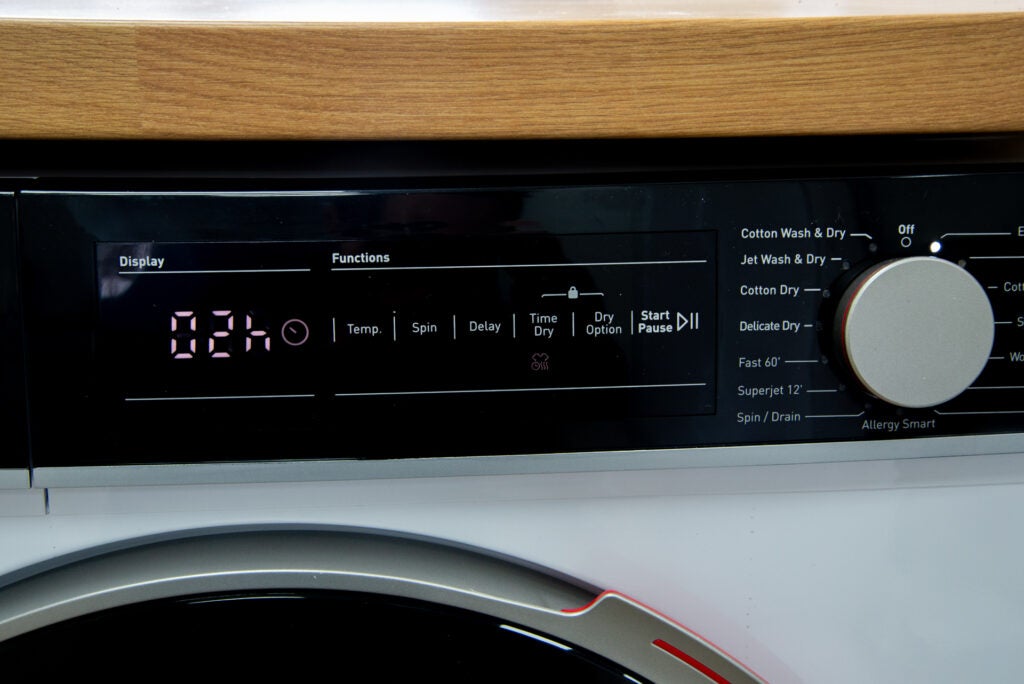
Similar to other Sharp washing machines I’ve reviewed, the ES-NDH0144WC-EN has no “on” button. Instead, the machine powers on as soon as the programme dial is turned. Well, first the LEDs around the programme dial light up in a clockwise direction; once that’s done, the dial can be used to select your desired wash programme.
It’s a slightly frustrating experience, particularly given that I accidentally turned the dial in the wrong direction to start, selecting the “off” feature – which meant I had to start from scratch again.
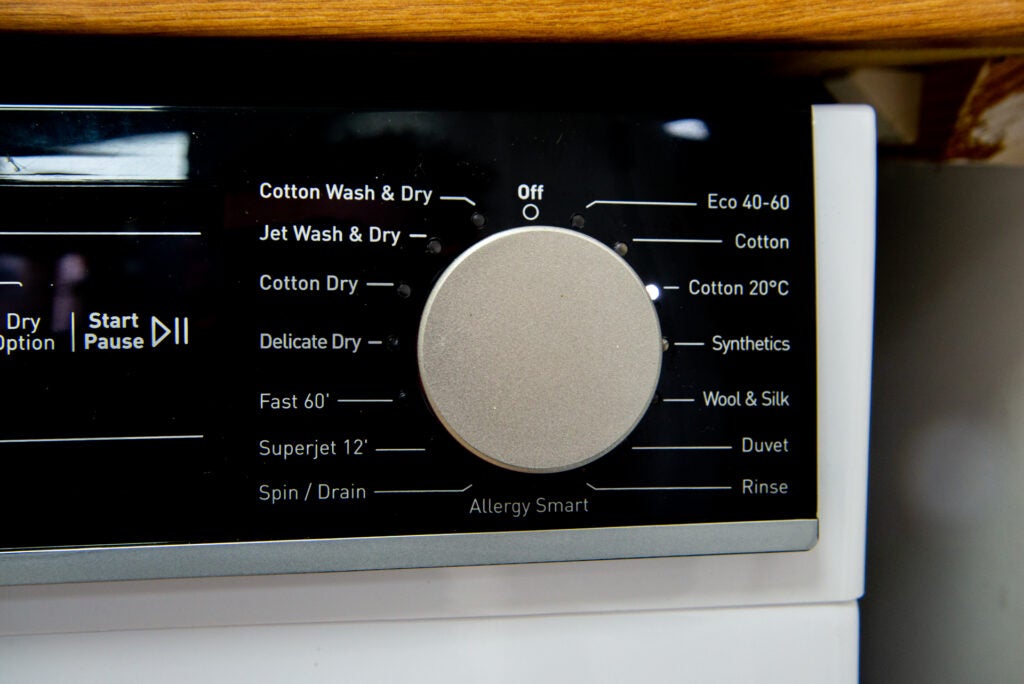
You’ll find a decent selection of programmes listed on the front of the Sharp, with all of the standard options covered. There are also a few specials, including a 12-minute Superjet wash for up to 2kg of clothes. While this isn’t great for heavily soiled items, if you have a few items that are a bit musty, this cycle will happily freshen up such items.
I couldn’t find an option to wash Cotton clothes at 30ºC, with the standard programme starting at 40ºC. So I used the Cotton 20ºC wash for testing instead.
Although you can add drying onto any programme, the Sharp also offers dedicated dry cycles. This is the real advantage of a washer-dryer: sticking on a load and coming back to clean, dry clothes. Just make sure you don’t exceed the maximum drying capacity.
Most drying modes have three options: Cupboard Dry, Hanger Dry and Iron Dry; but you can override these and set a specific drying time. I’d stick with the sensor options since they’re more efficient.
There’s a fairly wide portal door leading into the 10kg drum, but there’s no light inside this model – which is a feature of more expensive machines that I miss.
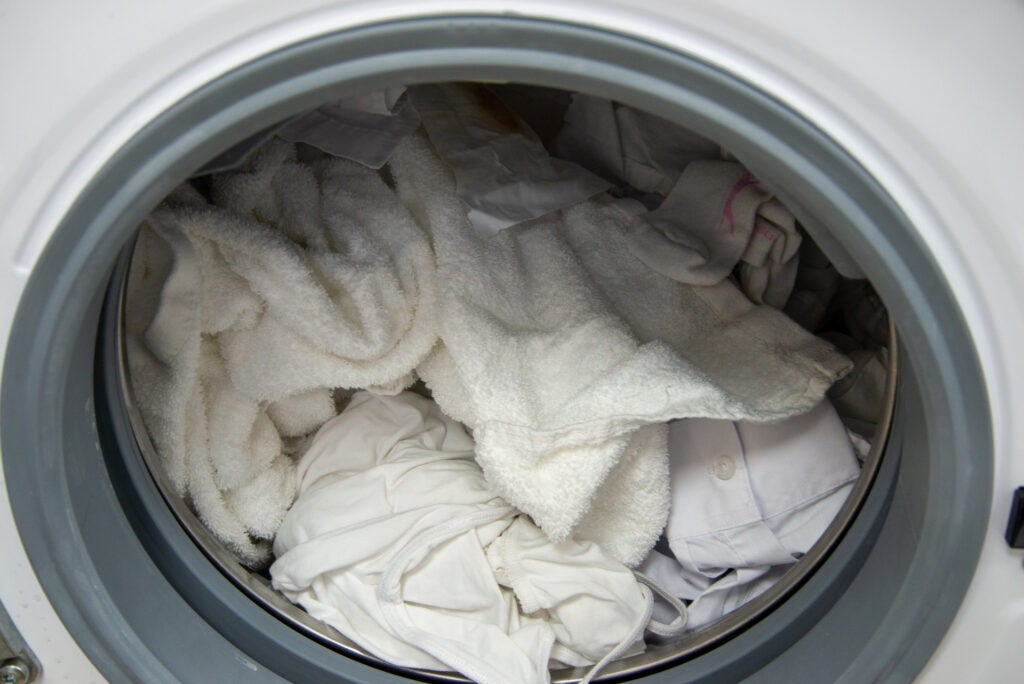
Sharp fits a standard detergent drawer here, which has dedicated slots for detergent, softener and pre-wash.
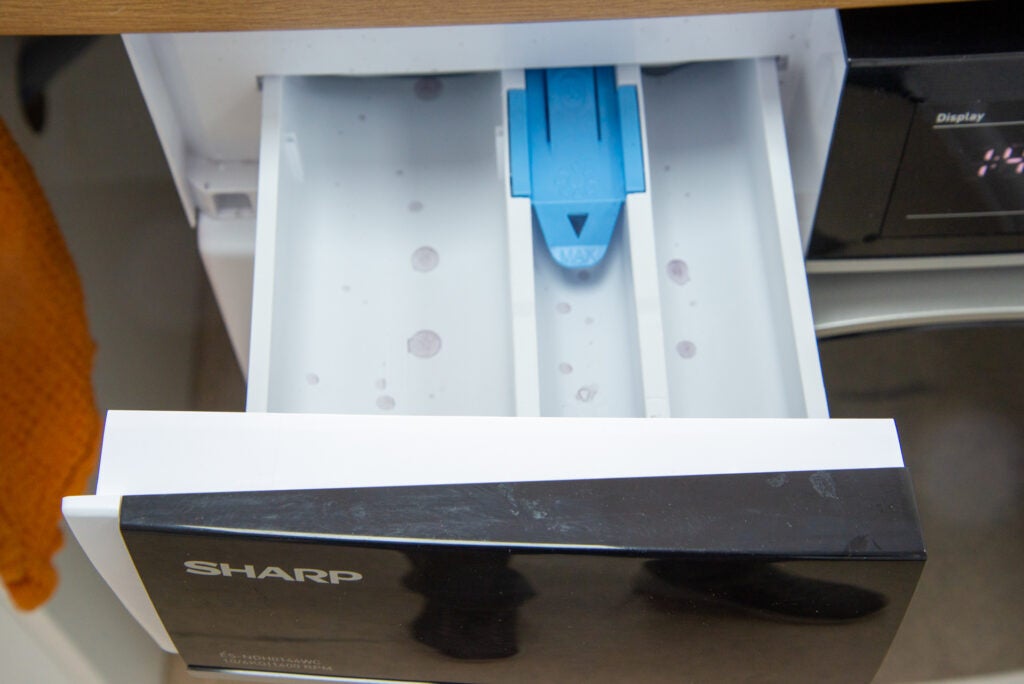
Performance
- Quite expensive to run
- Deals with stains well, except red wine
- Drying is inefficient
To test washing machines, I put them through a standard set of tests. I start with a 30ºC Cotton wash, but since this isn’t an option with the Sharp ES-NDH0144WC-EN, so I began with the Cotton 20ºC wash instead.
With my standard test load, energy usage was quite high at 0.478kWh, while water consumption came in at a hefty 72.3 litres. After completing a wash, I measured my clothes and found that they weighed an extra 39.17% as a result of water retention – which is towards the higher end of what I’d expect.
I tested stain removal, too, with stain sheets featuring (left to right) red wine, orange juice, ketchup, cooking oil and gravy stains. As you can see from the results, stain removal isn’t too bad; but there’s an outline of the ketchup mark remaining and the red wine stain is clearly visible.
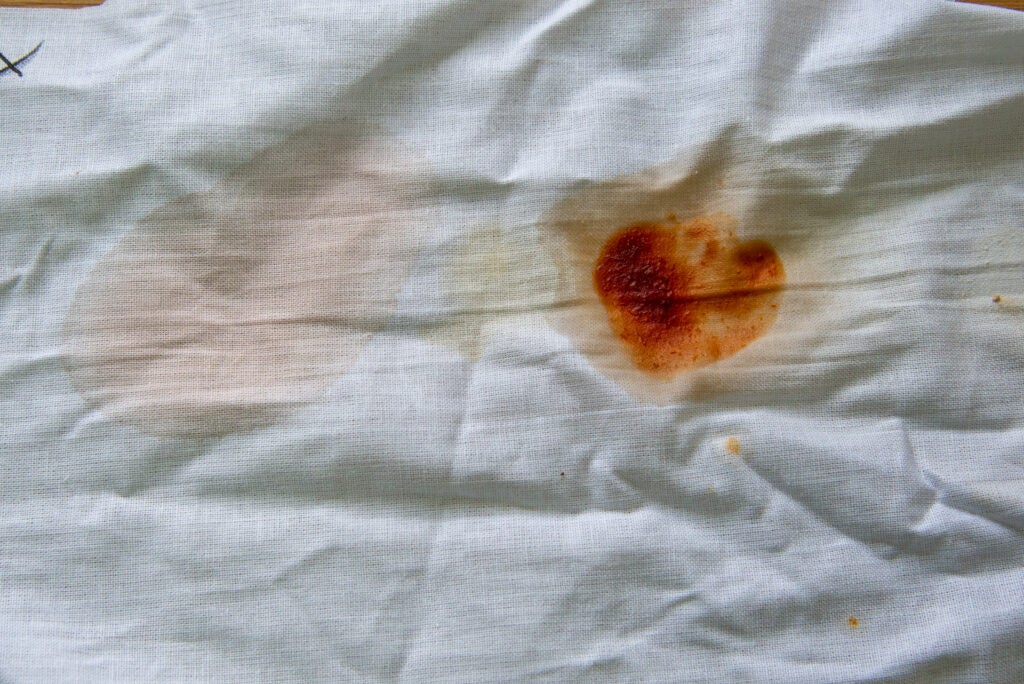
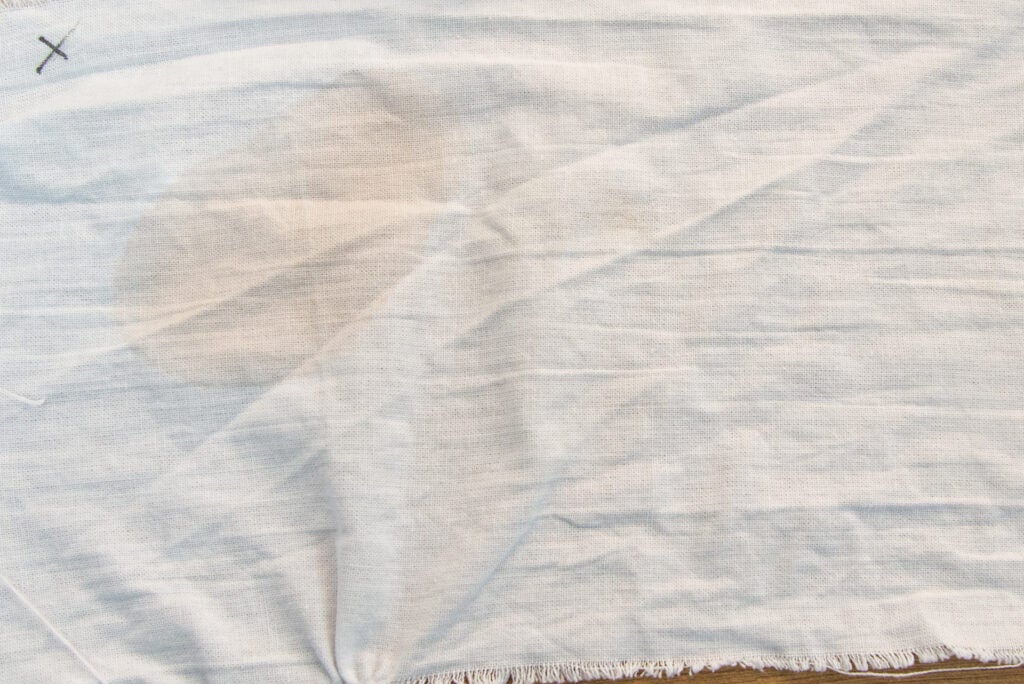
Next, I moved on to the standard Eco 40-60 wash. Power usage dropped to a more respectable 0.36kWh for my test load, and water dropped to 43.7-litres. Both figures remain higher than much of the competition, though.
With this cycle, water retention was worse, with my clothes gaining 43.59% in weight. That’s a lot of water left in the system. Stain removal results were similar, with the red wine and ketchup marks clearly visible at the end.
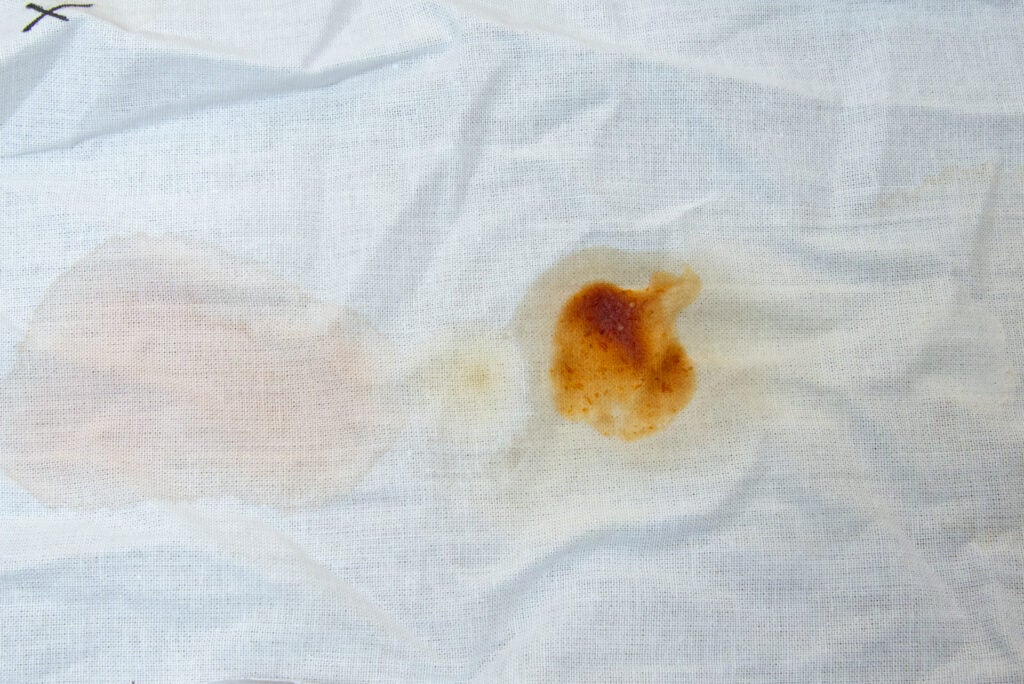
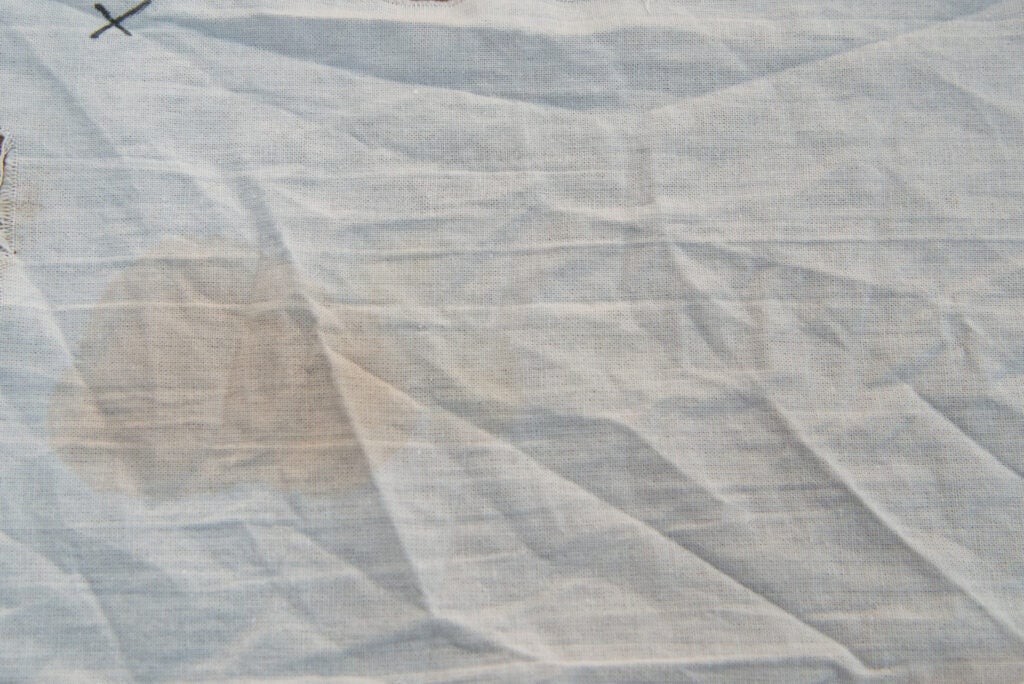
To test the tumble dryer, I started with the Cupboard Dry setting. This used a huge 2.396kWh of power as well as an additional 30.9 litres of water. At the end of the cycle, my clothes saw a 106.38% removal of water – the extra is because of fibres lost through the process. That’s a little on the high side.
The Hanger Dry option proved more economical: it used 1.442kWh of power and 28.7 litres of water. My clothes were better for it, too, with a 96.08% water removal rate. That meant that there was a little moisture left behind.
To test washer dryers on a level playing field, I use the official energy figures to work out the cost per full cycle. Based on the fact that an average UK household will get through 2644kg of washing per year, I worked out that the ES-NDH0144WC-EN could do that amount of washing in 164.4 loads, with a running cost per year of £36.99. That’s higher than the Candy Rapidó ROW4964DWMCE, which has a smaller drum.
Running costs for the tumble dryer were calculated assuming the UK average of 160 cycles per year at 6kg loads. Given the size of the drum, the Sharp ES-NDH0144WC-EN would do 160 cycles, at annual cost of £66.66. That’s a chunk higher than the Candy machine and explains the reason behind the Sharp ES-NDH0144WC-EN’s E rating for drying and a C rating for washing. I also measured sound at 76.8dB on the spin cycle, which is quite loud.
Latest deals
Should you buy it?
If you want a washer dryer with a large washing capacity, then this mid-priced machine fits the bill.
If you want a washer dryer with lower running costs, then there are better alternatives, particularly for the tumble drying side.
Final Thoughts
I welcome the Sharp ES-NDH0144WC-EN’s large drum, since it lets you do larger loads or wash bigger items, removing many of the restrictions that normally come with opting for washer dryers. It’s a good-enough washing machine when it comes to stain removal and drying, although the tough red wine stains proved a step too far for this model.
Running costs are quite high, particularly for the tumble dryer. Washer dryers are notoriously inefficient, but the E-class rating on this machine puts it towards the bottom of the table. At this price, the Candy Rapidó ROW4964DWMCE will prove a better choice for most.
How we test
Unlike other sites, we test every washer dryer we review thoroughly over an extended period of time. We use standard tests to compare features properly. We’ll always tell you what we find. We never, ever, accept money to review a product.
Find out more about how we test in our ethics policy.
We test compatibility with the main smart systems (HomeKit, Alexa, Google Assistant, SmartThings, IFTTT and more) to see how easy each machine is to remote control. Smart washing machines only.
We test each machine with the same stains to see which ones are best at cleaning.
We test with the same sets of clothes for each machine, run through a cycle on our test washing machine, so we can compare energy costs and drying performance between tumble dryers
FAQs
It can wash up to 10kg in one go.
You can tumble dry 6kg of wet clothes.
Trusted Reviews test data
Energy consumption 30C wash
Water consumption 30C wash
Percentage water remaining 30C wash
Energy consumption 40C wash
Water consumption 40C wash
Percentage water remaining 40C wash
Yearly running cost low use (washer dryers)
Yearly running cost med use (washer dryers)
Yearly running cost high use (washer dryers)
Energy consumption cupboard dry
Energy consumption hanging dry
Water consumption cupboard dry
Water consumption hanging dry
Sound (spin)


















